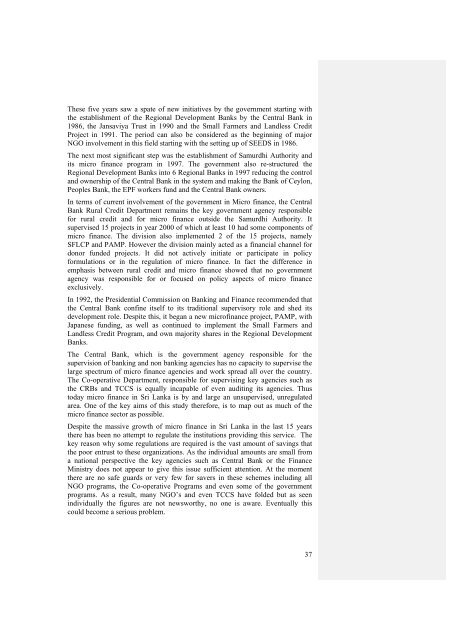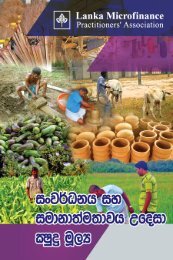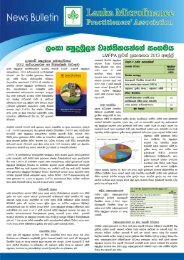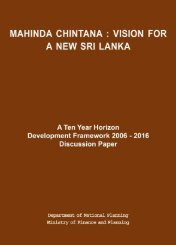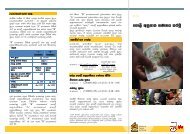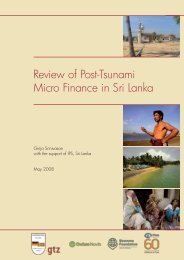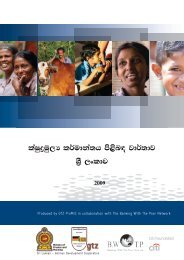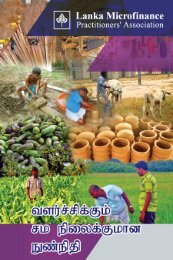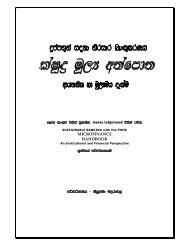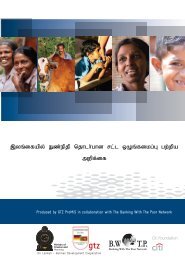National Microfinance Study of Sri Lanka: Survey of Practices and ...
National Microfinance Study of Sri Lanka: Survey of Practices and ...
National Microfinance Study of Sri Lanka: Survey of Practices and ...
Create successful ePaper yourself
Turn your PDF publications into a flip-book with our unique Google optimized e-Paper software.
These five years saw a spate <strong>of</strong> new initiatives by the government starting with<br />
the establishment <strong>of</strong> the Regional Development Banks by the Central Bank in<br />
1986, the Jansaviya Trust in 1990 <strong>and</strong> the Small Farmers <strong>and</strong> L<strong>and</strong>less Credit<br />
Project in 1991. The period can also be considered as the beginning <strong>of</strong> major<br />
NGO involvement in this field starting with the setting up <strong>of</strong> SEEDS in 1986.<br />
The next most significant step was the establishment <strong>of</strong> Samurdhi Authority <strong>and</strong><br />
its micro finance program in 1997. The government also re-structured the<br />
Regional Development Banks into 6 Regional Banks in 1997 reducing the control<br />
<strong>and</strong> ownership <strong>of</strong> the Central Bank in the system <strong>and</strong> making the Bank <strong>of</strong> Ceylon,<br />
Peoples Bank, the EPF workers fund <strong>and</strong> the Central Bank owners.<br />
In terms <strong>of</strong> current involvement <strong>of</strong> the government in Micro finance, the Central<br />
Bank Rural Credit Department remains the key government agency responsible<br />
for rural credit <strong>and</strong> for micro finance outside the Samurdhi Authority. It<br />
supervised 15 projects in year 2000 <strong>of</strong> which at least 10 had some components <strong>of</strong><br />
micro finance. The division also implemented 2 <strong>of</strong> the 15 projects, namely<br />
SFLCP <strong>and</strong> PAMP. However the division mainly acted as a financial channel for<br />
donor funded projects. It did not actively initiate or participate in policy<br />
formulations or in the regulation <strong>of</strong> micro finance. In fact the difference in<br />
emphasis between rural credit <strong>and</strong> micro finance showed that no government<br />
agency was responsible for or focused on policy aspects <strong>of</strong> micro finance<br />
exclusively.<br />
In 1992, the Presidential Commission on Banking <strong>and</strong> Finance recommended that<br />
the Central Bank confine itself to its traditional supervisory role <strong>and</strong> shed its<br />
development role. Despite this, it began a new micr<strong>of</strong>inance project, PAMP, with<br />
Japanese funding, as well as continued to implement the Small Farmers <strong>and</strong><br />
L<strong>and</strong>less Credit Program, <strong>and</strong> own majority shares in the Regional Development<br />
Banks.<br />
The Central Bank, which is the government agency responsible for the<br />
supervision <strong>of</strong> banking <strong>and</strong> non banking agencies has no capacity to supervise the<br />
large spectrum <strong>of</strong> micro finance agencies <strong>and</strong> work spread all over the country.<br />
The Co-operative Department, responsible for supervising key agencies such as<br />
the CRBs <strong>and</strong> TCCS is equally incapable <strong>of</strong> even auditing its agencies. Thus<br />
today micro finance in <strong>Sri</strong> <strong>Lanka</strong> is by <strong>and</strong> large an unsupervised, unregulated<br />
area. One <strong>of</strong> the key aims <strong>of</strong> this study therefore, is to map out as much <strong>of</strong> the<br />
micro finance sector as possible.<br />
Despite the massive growth <strong>of</strong> micro finance in <strong>Sri</strong> <strong>Lanka</strong> in the last 15 years<br />
there has been no attempt to regulate the institutions providing this service. The<br />
key reason why some regulations are required is the vast amount <strong>of</strong> savings that<br />
the poor entrust to these organizations. As the individual amounts are small from<br />
a national perspective the key agencies such as Central Bank or the Finance<br />
Ministry does not appear to give this issue sufficient attention. At the moment<br />
there are no safe guards or very few for savers in these schemes including all<br />
NGO programs, the Co-operative Programs <strong>and</strong> even some <strong>of</strong> the government<br />
programs. As a result, many NGO’s <strong>and</strong> even TCCS have folded but as seen<br />
individually the figures are not newsworthy, no one is aware. Eventually this<br />
could become a serious problem.<br />
37


